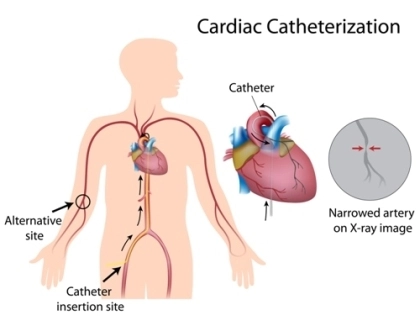CPT® Changes: Take Charge of CPT® 2017 Updates With a Cardiology Overview

Overlooking this moderate sedation news could cost you.
From angioplasty to coronary IVUS, CPT® 2017 changes are coming to your cardiology codes on Jan. 1, 2017. Start your preparations with this summary of the updates most likely to affect you.
Caution: These updates are based on the preliminary list of updates, and changes may occur before the code set is final. Keep checking back in to Cardiology Coding Alert for news about the final codes and details on proper use of your updated options.
Expect to Start Reporting Moderate Sedation Jan. 1
The biggest overall change you can expect to see in CPT® 2017 is the removal of the conscious (moderate) sedation symbol. In 2016, more than 400 codes, listed in CPT® Appendix G, have the circle-with-a-center-dot symbol. Remember: If a CPT® code has that symbol, you should not report sedation separately because the marked code includes moderate sedation performed by the same provider performing the procedure.
An impressive percentage of the Appendix G codes are electrophysiology and vascular codes. Sections where you’ll see the conscious sedation symbol removed include the following:
You also can anticipate the deletion of the current 2016 moderate sedation codes. You’ll replace the old codes with new 2017 ones that apply in 15-minute increments instead of the 30 minutes used in most of the 2016 codes.
Tip: The 2017 Medicare Physician Fee Schedule proposed rule indicates Medicare will be reducing RVUs for Appendix G codes because moderate sedation reimbursement will no longer be included in those codes (www.gpo.gov/fdsys/pkg/FR-2016-07-15/pdf/2016-16097.pdf).
You should be able to report moderate sedation in addition to your procedure code in 2017.
Prepare now so your practice is ready to properly document and code for moderate sedation starting on Jan. 1, 2017. Reporting moderate sedation separately is a change from what you’re used to as a cardiology coder, so be sure you don’t overlook this change.
This change and all the changes described here are important for cardiology coders to watch, says Christina Neighbors, MA, CPC, CCC, coding quality auditor for Conifer Health Solutions. With the variety of updates, training such as a seminar would be a good idea, she adds.
Keep in mind that along with code descriptor changes, we’ll also have new CPT® guidelines to learn, as well.
Look to Cat. I for LAAC Services
In 2016, you report left atrial appendage closure (LAAC) using Category III code 0281T (Percutaneous transcatheter closure of the left atrial appendage with implant, including fluoroscopy, transseptal puncture, catheter placement[s], left atrial angiography, left atrial appendage angiography, radiological supervision and interpretation).
CPT® 2017 will move LAAC to Category I. The 2016 code is carrier-priced, but the proposed 2017 MPFS shows a proposed work RVU of 13.00 for the Cat. I code.
Anticipate This Angioplasty Coding Change
2016: The 2016 code set includes 35450-35460 (Transluminal balloon angioplasty, open …) and 35471-35476 (Transluminal balloon angioplasty, percutaneous …) for balloon angioplasty of renal and visceral arteries, the aorta, the brachiocephalic trunk and branches, and veins.
To report radiological supervision and interpretation (S&I) for those balloon angioplasty services you use 75962-75968 and 75978.
2017: CPT® 2017 deletes both the surgical angioplasty codes and the related S&I codes. The updated code set will add choices that apply regardless of whether the service is open or percutaneous. Each code includes the angioplasty for a single vessel as well as the S&I required to perform that angioplasty, following the trend of combining a procedure and it’s S&I into a single code.
See What’s New for Dialysis Circuit Services
Dialysis arteriovenous shunt coding options will see a change in 2017. For coders who report these services, this will be a very important change, says Neighbors.
On the deleted list you’ll find 36147-36148 (Introduction of needle and/or catheter, arteriovenous shunt created for dialysis [graft/fistula] …).
You’ll have nine new codes specific to dialysis vascular services to choose from. The new codes allow you to report angiography, balloon angioplasty, stent placement, thrombectomy, thrombolysis, and permanent vascular occlusion performed in a dialysis circuit.
Make Room for Mechanochemical Endovenous Ablation
Expect to see CPT® 2017 add a mechanochemical option to your existing choices for endovenous ablation therapy of an incompetent vein.
You’ll have one code for the first vein and one code for any additional veins in a single extremity.
Add This AAA Screening Code to US Options
In 2016, HCPCS includes G0389 (Ultrasound B-scan and/or real time with image documentation; for abdominal aortic aneurysm [AAA] screening) for Medicare beneficiaries who can receive a AAA screening if they meet certain criteria.
CPT® 2017 will add a new code specific to AAA screening by ultrasound.
Look for New Lab Codes, Too
Your clinicians may be interested in some new lab codes coming our way. Watch for updates to options for cardiac ion channelopathies and inherited cardiomyopathy.
Insert OCT Into Coronary IVUS Code
Coronary IVUS code +92978 (Intravascular ultrasound [coronary vessel or graft] during diagnostic evaluation and/or therapeutic intervention including imaging supervision, interpretation and report; initial vessel [List separately in addition to code for primary procedure]) will see a shift in 2017.
Instead of covering just IVUS, the 2017 descriptor for +92978 will also specifically name Optical Coherence Tomography (OCT), which uses light instead of sound for endoluminal imaging. In 2016, you report OCT using Cat. III codes 0291T-0292T (Intravascular optical coherence tomography [coronary native vessel or graft] during diagnostic evaluation and/or therapeutic intervention, including imaging supervision, interpretation, and report …).
Keep Cat. III Ventricular Assist Options in Mind
Among the Category III additions, you’ll find a new set of codes effective Jan. 1 for permanently implantable aortic counterpulsation ventricular assist systems.
You’ll have codes for insertion and replacement, removal, repositioning, skin pocket relocation, programming device evaluation, and interrogation device evaluation.




